#southern prairie railway
Text

SPR 15, a GE 44-ton locomotive, pulls a passenger coach for Southern Prairie Railways in Ogema, Saskatchewan. A tourist railway, SPR is operated by the Ogema Heritage Railway Association and runs on trackage formerly part of the CPR Assiniboia subdivision, now owned by shortline railway company Red Coat Road & Rail. SPR's locomotive was purchased in 2010 from Conway Scenic Railway in Conway, New Hampshire, and was originally built in 1945 as a switcher for the Maine Central Railroad. Photo by Colin Arnot, via Railpictures.net
#saskatchewan#passenger rail#tourist railway#southern prairie railway#red coat road & rail#GE 44-ton switcher#trains#shortline
7 notes
·
View notes
Text

1944 06 01 Summer of 44 - Nicolas Trudgian
As the Allied invasion of northern France drew nearer, the entire length of southern England had seemingly become one huge army camp. While the local population went about its daily business as best it could, British and American troops massed at every point near the coast in readiness for the imminent crossing of the Channel. Though the RAF fighters of 10 Group were tasked in the Air Defense role, like all RAF squadrons that could be spared, they became involved with the softening up process, a pre-requisite of any large scale landing on enemy occupied territory. Under the leadership of Wing Commander Peter Brothers, 10 Groups Spitfire Wing based at Culmhead was heavily involved flying shipping patrols over the beachhead and Rhubarbs - low-level strikes of opportunity - disrupting enemy movements and communications.Nicolas Trudgians comprehensive painting Summer of 44 recreates with such realism a scene in southwest England just a few days before the Normandy landings in June 1944. Mark IX Spitfires of No. 126 Squadron, returning from combat over France, sweeps low over the local branch line railway station on their way back to Culmhead. Below, as the GWR Prairie tank engine pulls out of the station, American troops are assembling their equipment in readiness for the impending invasion. Adding great atmosphere to his composition, Nick has painted a classically peaceful English landscape, highlighting the unique contrast between war and peace that pervaded Britain during that summer of 44.
41 notes
·
View notes
Text
December 4th: Buffaloes
“From ocean to ocean”—so say the Americans; and these four words compose the general designation of the “great trunk line” which crosses the entire width of the United States. The Pacific Railroad is, however, really divided into two distinct lines: the Central Pacific, between San Francisco and Ogden, and the Union Pacific, between Ogden and Omaha. Five main lines connect Omaha with New York.
New York and San Francisco are thus united by an uninterrupted metal ribbon, which measures no less than three thousand seven hundred and eighty-six miles. Between Omaha and the Pacific the railway crosses a territory which is still infested by Indians and wild beasts, and a large tract which the Mormons, after they were driven from Illinois in 1845, began to colonise.
The journey from New York to San Francisco consumed, formerly, under the most favourable conditions, at least six months. It is now accomplished in seven days.
It was in 1862 that, in spite of the Southern Members of Congress, who wished a more southerly route, it was decided to lay the road between the forty-first and forty-second parallels. President Lincoln himself fixed the end of the line at Omaha, in Nebraska. The work was at once commenced, and pursued with true American energy; nor did the rapidity with which it went on injuriously affect its good execution. The road grew, on the prairies, a mile and a half a day. A locomotive, running on the rails laid down the evening before, brought the rails to be laid on the morrow, and advanced upon them as fast as they were put in position.
The Pacific Railroad is joined by several branches in Iowa, Kansas, Colorado, and Oregon. On leaving Omaha, it passes along the left bank of the Platte River as far as the junction of its northern branch, follows its southern branch, crosses the Laramie territory and the Wahsatch Mountains, turns the Great Salt Lake, and reaches Salt Lake City, the Mormon capital, plunges into the Tuilla Valley, across the American Desert, Cedar and Humboldt Mountains, the Sierra Nevada, and descends, viâ Sacramento, to the Pacific—its grade, even on the Rocky Mountains, never exceeding one hundred and twelve feet to the mile.
Such was the road to be traversed in seven days, which would enable Phileas Fogg—at least, so he hoped—to take the Atlantic steamer at New York on the 11th for Liverpool.
The car which he occupied was a sort of long omnibus on eight wheels, and with no compartments in the interior. It was supplied with two rows of seats, perpendicular to the direction of the train on either side of an aisle which conducted to the front and rear platforms. These platforms were found throughout the train, and the passengers were able to pass from one end of the train to the other. It was supplied with saloon cars, balcony cars, restaurants, and smoking-cars; theatre cars alone were wanting, and they will have these some day.
Book and news dealers, sellers of edibles, drinkables, and cigars, who seemed to have plenty of customers, were continually circulating in the aisles.
The train left Oakland station at six o’clock. It was already night, cold and cheerless, the heavens being overcast with clouds which seemed to threaten snow. The train did not proceed rapidly; counting the stoppages, it did not run more than twenty miles an hour, which was a sufficient speed, however, to enable it to reach Omaha within its designated time.
There was but little conversation in the car, and soon many of the passengers were overcome with sleep. Passepartout found himself beside the detective; but he did not talk to him. After recent events, their relations with each other had grown somewhat cold; there could no longer be mutual sympathy or intimacy between them. Fix’s manner had not changed; but Passepartout was very reserved, and ready to strangle his former friend on the slightest provocation.
Snow began to fall an hour after they started, a fine snow, however, which happily could not obstruct the train; nothing could be seen from the windows but a vast, white sheet, against which the smoke of the locomotive had a greyish aspect.
At eight o’clock a steward entered the car and announced that the time for going to bed had arrived; and in a few minutes the car was transformed into a dormitory. The backs of the seats were thrown back, bedsteads carefully packed were rolled out by an ingenious system, berths were suddenly improvised, and each traveller had soon at his disposition a comfortable bed, protected from curious eyes by thick curtains. The sheets were clean and the pillows soft. It only remained to go to bed and sleep which everybody did—while the train sped on across the State of California.
The country between San Francisco and Sacramento is not very hilly. The Central Pacific, taking Sacramento for its starting-point, extends eastward to meet the road from Omaha. The line from San Francisco to Sacramento runs in a north-easterly direction, along the American River, which empties into San Pablo Bay. The one hundred and twenty miles between these cities were accomplished in six hours, and towards midnight, while fast asleep, the travellers passed through Sacramento; so that they saw nothing of that important place, the seat of the State government, with its fine quays, its broad streets, its noble hotels, squares, and churches.
The train, on leaving Sacramento, and passing the junction, Roclin, Auburn, and Colfax, entered the range of the Sierra Nevada. ’Cisco was reached at seven in the morning; and an hour later the dormitory was transformed into an ordinary car, and the travellers could observe the picturesque beauties of the mountain region through which they were steaming. The railway track wound in and out among the passes, now approaching the mountain-sides, now suspended over precipices, avoiding abrupt angles by bold curves, plunging into narrow defiles, which seemed to have no outlet. The locomotive, its great funnel emitting a weird light, with its sharp bell, and its cow-catcher extended like a spur, mingled its shrieks and bellowings with the noise of torrents and cascades, and twined its smoke among the branches of the gigantic pines.
There were few or no bridges or tunnels on the route. The railway turned around the sides of the mountains, and did not attempt to violate nature by taking the shortest cut from one point to another.
The train entered the State of Nevada through the Carson Valley about nine o’clock, going always northeasterly; and at midday reached Reno, where there was a delay of twenty minutes for breakfast.
From this point the road, running along Humboldt River, passed northward for several miles by its banks; then it turned eastward, and kept by the river until it reached the Humboldt Range, nearly at the extreme eastern limit of Nevada.
Having breakfasted, Mr. Fogg and his companions resumed their places in the car, and observed the varied landscape which unfolded itself as they passed along the vast prairies, the mountains lining the horizon, and the creeks, with their frothy, foaming streams. Sometimes a great herd of buffaloes, massing together in the distance, seemed like a moveable dam. These innumerable multitudes of ruminating beasts often form an insurmountable obstacle to the passage of the trains; thousands of them have been seen passing over the track for hours together, in compact ranks. The locomotive is then forced to stop and wait till the road is once more clear.
This happened, indeed, to the train in which Mr. Fogg was travelling. About twelve o’clock a troop of ten or twelve thousand head of buffalo encumbered the track. The locomotive, slackening its speed, tried to clear the way with its cow-catcher; but the mass of animals was too great. The buffaloes marched along with a tranquil gait, uttering now and then deafening bellowings. There was no use of interrupting them, for, having taken a particular direction, nothing can moderate and change their course; it is a torrent of living flesh which no dam could contain.
The travellers gazed on this curious spectacle from the platforms; but Phileas Fogg, who had the most reason of all to be in a hurry, remained in his seat, and waited philosophically until it should please the buffaloes to get out of the way.
Passepartout was furious at the delay they occasioned, and longed to discharge his arsenal of revolvers upon them.
“What a country!” cried he. “Mere cattle stop the trains, and go by in a procession, just as if they were not impeding travel! Parbleu! I should like to know if Mr. Fogg foresaw this mishap in his programme! And here’s an engineer who doesn’t dare to run the locomotive into this herd of beasts!”
The engineer did not try to overcome the obstacle, and he was wise. He would have crushed the first buffaloes, no doubt, with the cow-catcher; but the locomotive, however powerful, would soon have been checked, the train would inevitably have been thrown off the track, and would then have been helpless.
The best course was to wait patiently, and regain the lost time by greater speed when the obstacle was removed. The procession of buffaloes lasted three full hours, and it was night before the track was clear. The last ranks of the herd were now passing over the rails, while the first had already disappeared below the southern horizon.
It was eight o’clock when the train passed through the defiles of the Humboldt Range, and half-past nine when it penetrated Utah, the region of the Great Salt Lake, the singular colony of the Mormons.
16 notes
·
View notes
Text

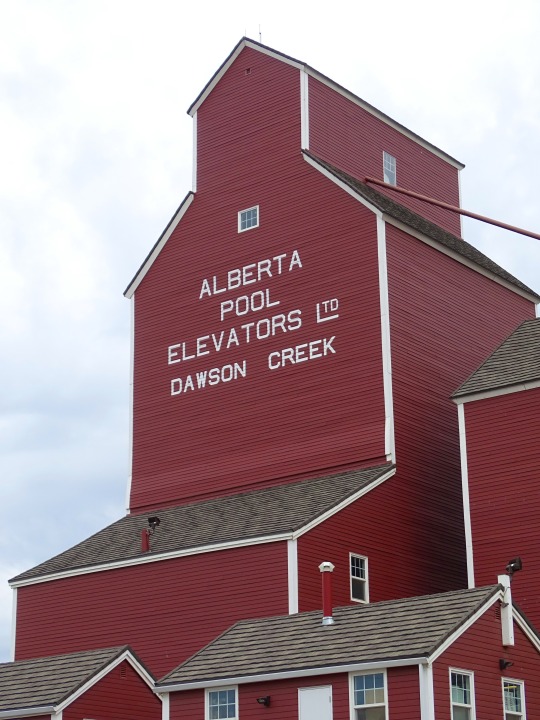
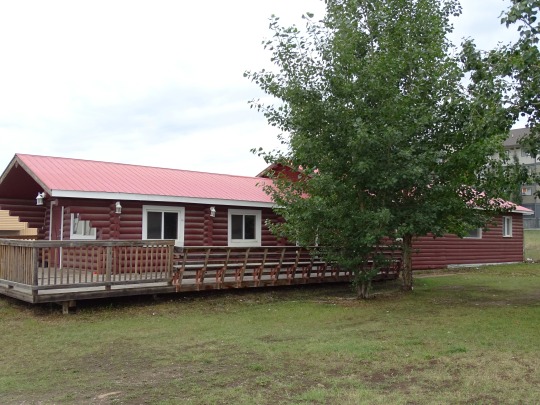
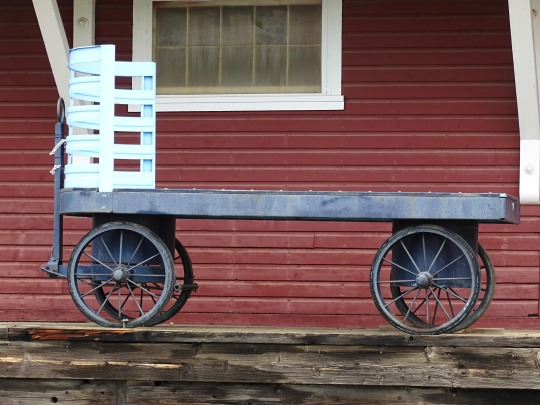

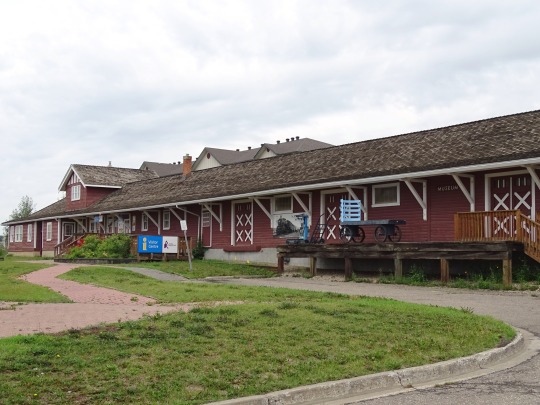

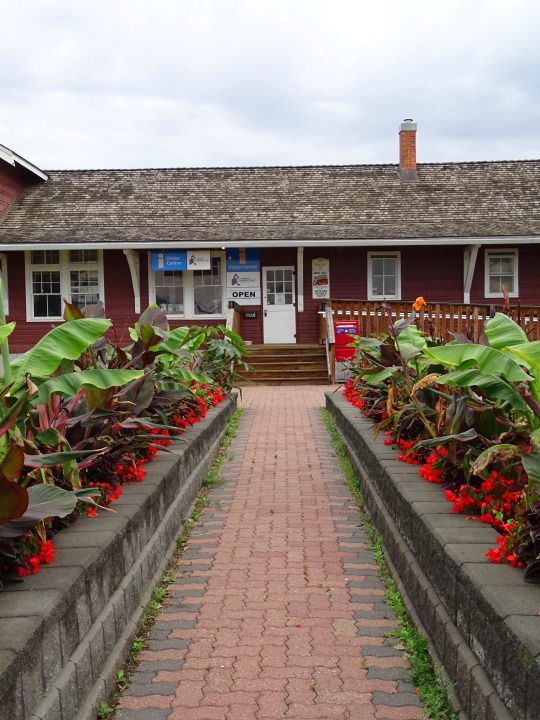
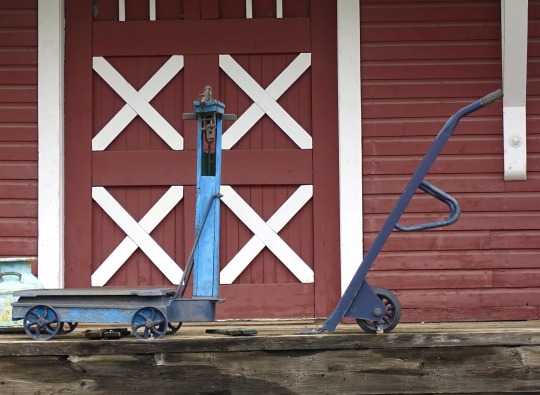

Dawson Creek, BC (No. 1)
Dawson Creek is a city in northeastern British Columbia, Canada. The municipality of 24.37 square kilometres (9.41 sq mi) had a population of 12,978 in 2016. Dawson Creek derives its name from the creek of the same name that runs through the community. The creek was named after George Mercer Dawson by a member of his land survey team when they passed through the area in August 1879. Once a small farming community, Dawson Creek became a regional centre after the western terminus of the Northern Alberta Railways was extended there in 1932. The community grew rapidly in 1942 as the US Army used the rail terminus as a transshipment point during construction of the Alaska Highway. In the 1950s, the city was connected to the interior of British Columbia via a highway and a railway through the Rocky Mountains. Since the 1960s, growth has slowed, but the area population has increased.
Dawson Creek is located in the dry and windy prairie land of the Peace River Country. As the seat of the Peace River Regional District and a service centre for the rural areas south of the Peace River, the city has been called the "Capital of the Peace". It is also known as the "Mile 0 City", referring to its location at the southern end of the Alaska Highway. It also has a heritage interpretation village, an art gallery, and a museum. Annual events include a fall fair and rodeo.
Source: Wikipedia
#Dawson Creek Art Gallery#prairie elevator#Dawson Creek#NAR Station Museum#Visitor Centre#travel#original photography#vacation#tourist attraction#landmark#cityscape#architecture#British Columbia#summer 2023#Canada#Alaska Highway#NAR Park#Alcan Highway#downtown#northeastern British Columbia#BC#Alaska-Canadian Highway#street scene#Northern Alberta Railway Park#flora#flower#tree#log cabin
1 note
·
View note
Text
Around the World in 80 Days by Jules Verne
CHAPTER XXVI.
IN WHICH PHILEAS FOGG AND PARTY TRAVEL BY THE PACIFIC RAILROAD
“From ocean to ocean”—so say the Americans; and these four words compose the general designation of the “great trunk line” which crosses the entire width of the United States. The Pacific Railroad is, however, really divided into two distinct lines: the Central Pacific, between San Francisco and Ogden, and the Union Pacific, between Ogden and Omaha. Five main lines connect Omaha with New York.
New York and San Francisco are thus united by an uninterrupted metal ribbon, which measures no less than three thousand seven hundred and eighty-six miles. Between Omaha and the Pacific the railway crosses a territory which is still infested by Indians and wild beasts, and a large tract which the Mormons, after they were driven from Illinois in 1845, began to colonise.
The journey from New York to San Francisco consumed, formerly, under the most favourable conditions, at least six months. It is now accomplished in seven days.
It was in 1862 that, in spite of the Southern Members of Congress, who wished a more southerly route, it was decided to lay the road between the forty-first and forty-second parallels. President Lincoln himself fixed the end of the line at Omaha, in Nebraska. The work was at once commenced, and pursued with true American energy; nor did the rapidity with which it went on injuriously affect its good execution. The road grew, on the prairies, a mile and a half a day. A locomotive, running on the rails laid down the evening before, brought the rails to be laid on the morrow, and advanced upon them as fast as they were put in position.
The Pacific Railroad is joined by several branches in Iowa, Kansas, Colorado, and Oregon. On leaving Omaha, it passes along the left bank of the Platte River as far as the junction of its northern branch, follows its southern branch, crosses the Laramie territory and the Wahsatch Mountains, turns the Great Salt Lake, and reaches Salt Lake City, the Mormon capital, plunges into the Tuilla Valley, across the American Desert, Cedar and Humboldt Mountains, the Sierra Nevada, and descends, viâ Sacramento, to the Pacific—its grade, even on the Rocky Mountains, never exceeding one hundred and twelve feet to the mile.
Such was the road to be traversed in seven days, which would enable Phileas Fogg—at least, so he hoped—to take the Atlantic steamer at New York on the 11th for Liverpool.
The car which he occupied was a sort of long omnibus on eight wheels, and with no compartments in the interior. It was supplied with two rows of seats, perpendicular to the direction of the train on either side of an aisle which conducted to the front and rear platforms. These platforms were found throughout the train, and the passengers were able to pass from one end of the train to the other. It was supplied with saloon cars, balcony cars, restaurants, and smoking-cars; theatre cars alone were wanting, and they will have these some day.
Book and news dealers, sellers of edibles, drinkables, and cigars, who seemed to have plenty of customers, were continually circulating in the aisles.
The train left Oakland station at six o’clock. It was already night, cold and cheerless, the heavens being overcast with clouds which seemed to threaten snow. The train did not proceed rapidly; counting the stoppages, it did not run more than twenty miles an hour, which was a sufficient speed, however, to enable it to reach Omaha within its designated time.
There was but little conversation in the car, and soon many of the passengers were overcome with sleep. Passepartout found himself beside the detective; but he did not talk to him. After recent events, their relations with each other had grown somewhat cold; there could no longer be mutual sympathy or intimacy between them. Fix’s manner had not changed; but Passepartout was very reserved, and ready to strangle his former friend on the slightest provocation.
Snow began to fall an hour after they started, a fine snow, however, which happily could not obstruct the train; nothing could be seen from the windows but a vast, white sheet, against which the smoke of the locomotive had a greyish aspect.
At eight o’clock a steward entered the car and announced that the time for going to bed had arrived; and in a few minutes the car was transformed into a dormitory. The backs of the seats were thrown back, bedsteads carefully packed were rolled out by an ingenious system, berths were suddenly improvised, and each traveller had soon at his disposition a comfortable bed, protected from curious eyes by thick curtains. The sheets were clean and the pillows soft. It only remained to go to bed and sleep which everybody did—while the train sped on across the State of California.
The country between San Francisco and Sacramento is not very hilly. The Central Pacific, taking Sacramento for its starting-point, extends eastward to meet the road from Omaha. The line from San Francisco to Sacramento runs in a north-easterly direction, along the American River, which empties into San Pablo Bay. The one hundred and twenty miles between these cities were accomplished in six hours, and towards midnight, while fast asleep, the travellers passed through Sacramento; so that they saw nothing of that important place, the seat of the State government, with its fine quays, its broad streets, its noble hotels, squares, and churches.
The train, on leaving Sacramento, and passing the junction, Roclin, Auburn, and Colfax, entered the range of the Sierra Nevada. ’Cisco was reached at seven in the morning; and an hour later the dormitory was transformed into an ordinary car, and the travellers could observe the picturesque beauties of the mountain region through which they were steaming. The railway track wound in and out among the passes, now approaching the mountain-sides, now suspended over precipices, avoiding abrupt angles by bold curves, plunging into narrow defiles, which seemed to have no outlet. The locomotive, its great funnel emitting a weird light, with its sharp bell, and its cow-catcher extended like a spur, mingled its shrieks and bellowings with the noise of torrents and cascades, and twined its smoke among the branches of the gigantic pines.
There were few or no bridges or tunnels on the route. The railway turned around the sides of the mountains, and did not attempt to violate nature by taking the shortest cut from one point to another.
The train entered the State of Nevada through the Carson Valley about nine o’clock, going always northeasterly; and at midday reached Reno, where there was a delay of twenty minutes for breakfast.
From this point the road, running along Humboldt River, passed northward for several miles by its banks; then it turned eastward, and kept by the river until it reached the Humboldt Range, nearly at the extreme eastern limit of Nevada.
Having breakfasted, Mr. Fogg and his companions resumed their places in the car, and observed the varied landscape which unfolded itself as they passed along the vast prairies, the mountains lining the horizon, and the creeks, with their frothy, foaming streams. Sometimes a great herd of buffaloes, massing together in the distance, seemed like a moveable dam. These innumerable multitudes of ruminating beasts often form an insurmountable obstacle to the passage of the trains; thousands of them have been seen passing over the track for hours together, in compact ranks. The locomotive is then forced to stop and wait till the road is once more clear.
This happened, indeed, to the train in which Mr. Fogg was travelling. About twelve o’clock a troop of ten or twelve thousand head of buffalo encumbered the track. The locomotive, slackening its speed, tried to clear the way with its cow-catcher; but the mass of animals was too great. The buffaloes marched along with a tranquil gait, uttering now and then deafening bellowings. There was no use of interrupting them, for, having taken a particular direction, nothing can moderate and change their course; it is a torrent of living flesh which no dam could contain.
The travellers gazed on this curious spectacle from the platforms; but Phileas Fogg, who had the most reason of all to be in a hurry, remained in his seat, and waited philosophically until it should please the buffaloes to get out of the way.
Passepartout was furious at the delay they occasioned, and longed to discharge his arsenal of revolvers upon them.
“What a country!” cried he. “Mere cattle stop the trains, and go by in a procession, just as if they were not impeding travel! Parbleu! I should like to know if Mr. Fogg foresaw this mishap in his programme! And here’s an engineer who doesn’t dare to run the locomotive into this herd of beasts!”
The engineer did not try to overcome the obstacle, and he was wise. He would have crushed the first buffaloes, no doubt, with the cow-catcher; but the locomotive, however powerful, would soon have been checked, the train would inevitably have been thrown off the track, and would then have been helpless.
The best course was to wait patiently, and regain the lost time by greater speed when the obstacle was removed. The procession of buffaloes lasted three full hours, and it was night before the track was clear. The last ranks of the herd were now passing over the rails, while the first had already disappeared below the southern horizon.
It was eight o’clock when the train passed through the defiles of the Humboldt Range, and half-past nine when it penetrated Utah, the region of the Great Salt Lake, the singular colony of the Mormons.
CHAPTER XXVII.
IN WHICH PASSEPARTOUT UNDERGOES, AT A SPEED OF TWENTY MILES AN HOUR, A COURSE OF MORMON HISTORY
During the night of the 5th of December, the train ran south-easterly for about fifty miles; then rose an equal distance in a north-easterly direction, towards the Great Salt Lake.
Passepartout, about nine o’clock, went out upon the platform to take the air. The weather was cold, the heavens grey, but it was not snowing. The sun’s disc, enlarged by the mist, seemed an enormous ring of gold, and Passepartout was amusing himself by calculating its value in pounds sterling, when he was diverted from this interesting study by a strange-looking personage who made his appearance on the platform.
This personage, who had taken the train at Elko, was tall and dark, with black moustache, black stockings, a black silk hat, a black waistcoat, black trousers, a white cravat, and dogskin gloves. He might have been taken for a clergyman. He went from one end of the train to the other, and affixed to the door of each car a notice written in manuscript.
Passepartout approached and read one of these notices, which stated that Elder William Hitch, Mormon missionary, taking advantage of his presence on train No. 48, would deliver a lecture on Mormonism in car No. 117, from eleven to twelve o’clock; and that he invited all who were desirous of being instructed concerning the mysteries of the religion of the “Latter Day Saints” to attend.
“I’ll go,” said Passepartout to himself. He knew nothing of Mormonism except the custom of polygamy, which is its foundation.
The news quickly spread through the train, which contained about one hundred passengers, thirty of whom, at most, attracted by the notice, ensconced themselves in car No. 117. Passepartout took one of the front seats. Neither Mr. Fogg nor Fix cared to attend.
At the appointed hour Elder William Hitch rose, and, in an irritated voice, as if he had already been contradicted, said, “I tell you that Joe Smith is a martyr, that his brother Hiram is a martyr, and that the persecutions of the United States Government against the prophets will also make a martyr of Brigham Young. Who dares to say the contrary?”
No one ventured to gainsay the missionary, whose excited tone contrasted curiously with his naturally calm visage. No doubt his anger arose from the hardships to which the Mormons were actually subjected. The government had just succeeded, with some difficulty, in reducing these independent fanatics to its rule. It had made itself master of Utah, and subjected that territory to the laws of the Union, after imprisoning Brigham Young on a charge of rebellion and polygamy. The disciples of the prophet had since redoubled their efforts, and resisted, by words at least, the authority of Congress. Elder Hitch, as is seen, was trying to make proselytes on the very railway trains.
Then, emphasising his words with his loud voice and frequent gestures, he related the history of the Mormons from Biblical times: how that, in Israel, a Mormon prophet of the tribe of Joseph published the annals of the new religion, and bequeathed them to his son Mormon; how, many centuries later, a translation of this precious book, which was written in Egyptian, was made by Joseph Smith, junior, a Vermont farmer, who revealed himself as a mystical prophet in 1825; and how, in short, the celestial messenger appeared to him in an illuminated forest, and gave him the annals of the Lord.
Several of the audience, not being much interested in the missionary’s narrative, here left the car; but Elder Hitch, continuing his lecture, related how Smith, junior, with his father, two brothers, and a few disciples, founded the church of the “Latter Day Saints,” which, adopted not only in America, but in England, Norway and Sweden, and Germany, counts many artisans, as well as men engaged in the liberal professions, among its members; how a colony was established in Ohio, a temple erected there at a cost of two hundred thousand dollars, and a town built at Kirkland; how Smith became an enterprising banker, and received from a simple mummy showman a papyrus scroll written by Abraham and several famous Egyptians.
The Elder’s story became somewhat wearisome, and his audience grew gradually less, until it was reduced to twenty passengers. But this did not disconcert the enthusiast, who proceeded with the story of Joseph Smith’s bankruptcy in 1837, and how his ruined creditors gave him a coat of tar and feathers; his reappearance some years afterwards, more honourable and honoured than ever, at Independence, Missouri, the chief of a flourishing colony of three thousand disciples, and his pursuit thence by outraged Gentiles, and retirement into the Far West.
Ten hearers only were now left, among them honest Passepartout, who was listening with all his ears. Thus he learned that, after long persecutions, Smith reappeared in Illinois, and in 1839 founded a community at Nauvoo, on the Mississippi, numbering twenty-five thousand souls, of which he became mayor, chief justice, and general-in-chief; that he announced himself, in 1843, as a candidate for the Presidency of the United States; and that finally, being drawn into ambuscade at Carthage, he was thrown into prison, and assassinated by a band of men disguised in masks.
Passepartout was now the only person left in the car, and the Elder, looking him full in the face, reminded him that, two years after the assassination of Joseph Smith, the inspired prophet, Brigham Young, his successor, left Nauvoo for the banks of the Great Salt Lake, where, in the midst of that fertile region, directly on the route of the emigrants who crossed Utah on their way to California, the new colony, thanks to the polygamy practised by the Mormons, had flourished beyond expectations.
“And this,” added Elder William Hitch, “this is why the jealousy of Congress has been aroused against us! Why have the soldiers of the Union invaded the soil of Utah? Why has Brigham Young, our chief, been imprisoned, in contempt of all justice? Shall we yield to force? Never! Driven from Vermont, driven from Illinois, driven from Ohio, driven from Missouri, driven from Utah, we shall yet find some independent territory on which to plant our tents. And you, my brother,” continued the Elder, fixing his angry eyes upon his single auditor, “will you not plant yours there, too, under the shadow of our flag?”
“No!” replied Passepartout courageously, in his turn retiring from the car, and leaving the Elder to preach to vacancy.
During the lecture the train had been making good progress, and towards half-past twelve it reached the northwest border of the Great Salt Lake. Thence the passengers could observe the vast extent of this interior sea, which is also called the Dead Sea, and into which flows an American Jordan. It is a picturesque expanse, framed in lofty crags in large strata, encrusted with white salt—a superb sheet of water, which was formerly of larger extent than now, its shores having encroached with the lapse of time, and thus at once reduced its breadth and increased its depth.
The Salt Lake, seventy miles long and thirty-five wide, is situated three miles eight hundred feet above the sea. Quite different from Lake Asphaltite, whose depression is twelve hundred feet below the sea, it contains considerable salt, and one quarter of the weight of its water is solid matter, its specific weight being 1,170, and, after being distilled, 1,000. Fishes are, of course, unable to live in it, and those which descend through the Jordan, the Weber, and other streams soon perish.
The country around the lake was well cultivated, for the Mormons are mostly farmers; while ranches and pens for domesticated animals, fields of wheat, corn, and other cereals, luxuriant prairies, hedges of wild rose, clumps of acacias and milk-wort, would have been seen six months later. Now the ground was covered with a thin powdering of snow.
The train reached Ogden at two o’clock, where it rested for six hours, Mr. Fogg and his party had time to pay a visit to Salt Lake City, connected with Ogden by a branch road; and they spent two hours in this strikingly American town, built on the pattern of other cities of the Union, like a checker-board, “with the sombre sadness of right-angles,” as Victor Hugo expresses it. The founder of the City of the Saints could not escape from the taste for symmetry which distinguishes the Anglo-Saxons. In this strange country, where the people are certainly not up to the level of their institutions, everything is done “squarely”—cities, houses, and follies.
The travellers, then, were promenading, at three o’clock, about the streets of the town built between the banks of the Jordan and the spurs of the Wahsatch Range. They saw few or no churches, but the prophet’s mansion, the court-house, and the arsenal, blue-brick houses with verandas and porches, surrounded by gardens bordered with acacias, palms, and locusts. A clay and pebble wall, built in 1853, surrounded the town; and in the principal street were the market and several hotels adorned with pavilions. The place did not seem thickly populated. The streets were almost deserted, except in the vicinity of the temple, which they only reached after having traversed several quarters surrounded by palisades. There were many women, which was easily accounted for by the “peculiar institution” of the Mormons; but it must not be supposed that all the Mormons are polygamists. They are free to marry or not, as they please; but it is worth noting that it is mainly the female citizens of Utah who are anxious to marry, as, according to the Mormon religion, maiden ladies are not admitted to the possession of its highest joys. These poor creatures seemed to be neither well off nor happy. Some—the more well-to-do, no doubt—wore short, open, black silk dresses, under a hood or modest shawl; others were habited in Indian fashion.
Passepartout could not behold without a certain fright these women, charged, in groups, with conferring happiness on a single Mormon. His common sense pitied, above all, the husband. It seemed to him a terrible thing to have to guide so many wives at once across the vicissitudes of life, and to conduct them, as it were, in a body to the Mormon paradise with the prospect of seeing them in the company of the glorious Smith, who doubtless was the chief ornament of that delightful place, to all eternity. He felt decidedly repelled from such a vocation, and he imagined—perhaps he was mistaken—that the fair ones of Salt Lake City cast rather alarming glances on his person. Happily, his stay there was but brief. At four the party found themselves again at the station, took their places in the train, and the whistle sounded for starting. Just at the moment, however, that the locomotive wheels began to move, cries of “Stop! stop!” were heard.
Trains, like time and tide, stop for no one. The gentleman who uttered the cries was evidently a belated Mormon. He was breathless with running. Happily for him, the station had neither gates nor barriers. He rushed along the track, jumped on the rear platform of the train, and fell, exhausted, into one of the seats.
Passepartout, who had been anxiously watching this amateur gymnast, approached him with lively interest, and learned that he had taken flight after an unpleasant domestic scene.
When the Mormon had recovered his breath, Passepartout ventured to ask him politely how many wives he had; for, from the manner in which he had decamped, it might be thought that he had twenty at least.
“One, sir,” replied the Mormon, raising his arms heavenward —“one, and that was enough!”
1 note
·
View note
Text
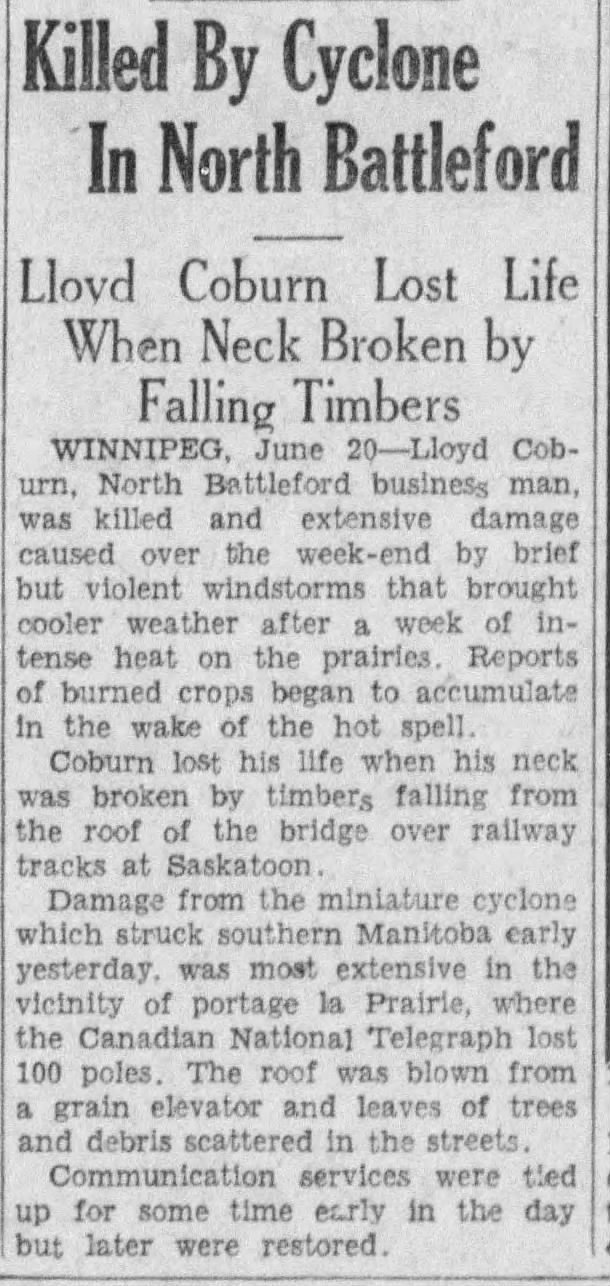
"Killed By Cyclone In North Battleford," Kingston Whig-Standard. June 20, 1933. Page 3.
----
Lloyd Coburn Lost Life When Neck Broken by Falling Timbers
---
WINNIPEG, June 20 - Lloyd Coburn, North Battleford business man, was killed and extensive damage caused over the week-end by brief but violent windstorms that brought cooler weather after a week of intense heat on the prairies. Reports of burned crops began to accumulate In the wake of the hot spell.
Coburn lost his life when his neck was broken by timbers falling from the roof of the bridge over railway tracks at Saskatoon.
Damage from the miniature cyclone which struck southern Manitoba early yesterday, was most extensive in the vicinity of Portage la Prairie, where the Canadian National Telegraph lost 100 poles. The roof was blown from a grain elevator and leaves of trees and debris scattered in the streets.
Communication services were tied up for some time early in the day but later were restored.
#winnipeg#north battleford#saskatoon#portage la prairie#prairie storm#tornado damage#tornado#natural disaster#canadian prairies#prairies history#great depression in canada
0 notes
Text
Severn Valley Railway Spring steam gala — Whizzbang1698
This years Severn valley railway spring steam gala takes place between 14 and 16 April 2023, Guests Locomotive Include GWR Small Prairie 4555 and GWR Castle class Locomotive No. 4079 ‘Pendennis Castle’ and 2-6-0 2MT no.78018. The home fleet includes GWR Hall class locomotive no. 4930 ‘Hagley Hall’, newly repainted and Renumbered southern Region Pacific […]
Severn Valley Railway Spring steam gala…

View On WordPress
0 notes
Photo

CHARACTER BIO: MEDICINE HAT
[ Bio Page ] [ Relationships ] [ Trivia ]
(These relationships are based on a combination of my own impressions of current and historical events, shared interests, and supplied with a little personality horoscope-ing where information is lacking!)
Madeline’s Clubs
Canada Pacific Railway (CPR) Club
Northwest Mounted Police (NWMP) Club
Southern Alberta Club (Treaty 7)
Mid-Sized Cities Club
South Saskatchewan River Club
Transcription below the cut.
Relationships
Calgary / Calvin
Madeline discovered natural gas first, throwing Calvin into a fit of jealousy. She teased him a lot when they were younger and called him "piggy" for being loud and greedy, but their relationship has since mellowed a great deal and they consider each other friends.
Lethbridge / Lilith
Madeline and Lilith are close neighbours who anchor the two corners of Southern Alberta. Lilith is the most experienced at bringing Madeline out of her shell, while Madeline reminds her to slow down and savour things, making them a well balanced pair.
Edmonton / Edward
Madeline mostly knows Edward in work-related contexts and they are not particularly close in person. However, the two seem to like each other's text-based roasts. Madeline appreciates Ed's wry and mildly salty comments, even if she rarely says so.
Red Deer / Red
Madeline shares Red's enthusiasm for sports and automobiles as well as more crafty pursuits, making them fast friends in the mid-size city club. The two especially enjoy testing out new wheels at Madeline's local speedway.
Banff / Eleanor
Madeline and Eleanor are both very proud of their identities as cities who place the utmost importance on careful planning rather than rapid growth. Madeline enjoys unwinding with Eleanor in the ceramics studio or in the great outdoors.
Grande Prairie / Josephine
Madeline is usually ruffled a little by Josephine's brash nature and her tendency to dominate a conversation, and in many ways the two could not be more opposite. That said, Madeline does feel they have a lot in common and under the right circumstances would make a dynamic pair.
Fort McMurray / Mac
Madeline and Mac rarely cross paths much given the distance, and from afar it might look like they rarely talk at all. Madeline is one of the few people who recognizes Mac's erratic behaviours as masking his shyness, and rarely minds spending a quiet moment with him.
Other Relationships
Madeline shares the South Saskatchewan River with Saskatoon. The two cities are comparable in size and small-town feel. While Madeline is willing to step up and arbitrate between the two provinces, and is the most likely to be found chatting away with her Saskatchewan neighbours, she also takes her duties on rat patrol very seriously indeed.
#aph oc#hetalia oc#hws oc#aph alberta#aph medicine hat#oc_tober#oc tober#digital art#clip studio paint#hapo art#projectcanada cities#pc: medicine hat#madeline hargrave#battle ref
17 notes
·
View notes
Text
Canadian government land managers and corporate investors in the early twentieth century: “Damn, we have a nation-state that’s already so full of potential wealth which extends to the coasts of three oceans and borders the Great Lakes waterway network, containing prairies for monoculture agricultural extraction; vast timber reserves in the Pacific rainforests and boreal forests; metals and mining quarries in the Rockies; and oil and natural gas wells that we can pillage. BUT we HAVE to also find a way to reap wealth from every corner, every edge of the continent, including the distant reaches of the Arctic taiga and tundra. So let’s ... see if we can cross domesticated cattle with yaks, or import European reindeer herds to replace native caribou. We don’t want the bison to go extinct. Not because we ‘care about the ecosystem’ or something. No, instead, we want to preserve the species so that we can selectively breed bison to make the Ultimate Profitable Arctic Cattle-Machine. Also, we like what the United States is doing in Alaska. We think that establishing agricultural industries in these ‘frontier’ environments would help us to civilize Indigenous people and expand the prosperous reach of glorious civilization.”
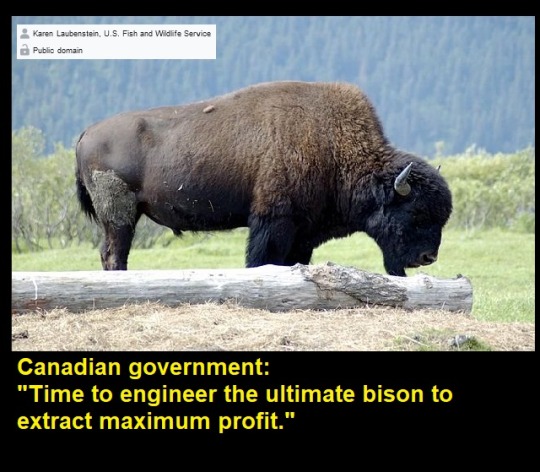
Excerpt:
---
The prospect of raising domesticated livestock in the extremely cold and isolated regions of Canada’s norther forests might appear, at first glance, to be a questionable undertaking. From the 1890s to the 1940s, however, a combination of land hunger, railway development, and dry conditions in the southern prairies encouraged would-be settlers to colonize an agricultural fringe that stretched along the southern edge of the boreal forest from Quebec to the interior valleys of northern British Columbia. [...] By 1981, there were only forty-seven head of cattle in the Northwest Territories. [...]
In the early twentieth century, senior bureaucrats within the Dominion departments of the Interior and Agriculture began to consider ways of overcoming the inherent limitations associated with ranching European livestock in the Far North. They gave serious consideration to the idea of domesticating northern wildlife on a large scale as the basis for settled agriculture in the region. Animals such as caribou and especially muskoxen, it was thought, could better withstand the harsh climate and survive on the sedges and lichens that dominate the Arctic prairie. The federal government also established breeding programs designed to cross cattle with bison or yak to create a new range animal that could easily tolerate cold climates.
---
These programs yielded few practical results, but the enthusiasm for stocking northern environments with exploitable game populations was such that from 1925 to 1928 wildlife officials with the National Parks Branch and the Northwest Territories and Yukon Branch collaborated on a program to introduce close to seven thousand plains bison from southern Alberta to the northern wood bison range in Wood Buffalo National Park. [...]
Maxwell Graham, chief of the Animal Division in the federal government and the most fervent promoter of the bison transfer among senior wildlife officials, argued for the creation of the original wood bison preserve because “a reserve stock of pure blood bison of the highest potency should be kept in reserve, so that the ultimate fixed type of new range animal may continue to pass on to successive generations the potent qualities of the true bison, hardiness, thriftiness, a valuable robe, and first-class beef qualities.” [...]
---
Game ranching was not the only economic activity that federal officials proposed as a pathway leading toward northern agricultural development. Nothing, in fact, captured the imagination of bureaucrats and private promoters in the early twentieth century more than the idea of importing domesticated reindeer from northern Europe as the vanguard of a settled and prosperous agricultural civilization in northern Canada.
In large measure, the enthusiasm for reindeer introductions among senior politicians and bureaucrats within the Departments of the Interior and Indian Affairs was a response to the success of American attempts [...] along the western coast of Alaska [...]. By 1916, the reindeer herd numbered just over 82,000 and an Alaskan Bureau of Education Report proudly proclaimed that the Inuit has been assimilated into a new social and ecological order: "within less than a generation, the [slur] throughout northern and western Alaska have been advanced through one entire stage of civilization [...].” In 1929 the Dominion government purchased three thousand reindeer from the U.S. based Lomen Reindeer Company [...].
---
Text excerpt from: Liza Piper and John Sandlos. “A Broken Frontier: Ecological Imperialism in the Canadian North.” Environmental History Volume 12, Number 4. 2007. [Bold emphasis and some paragraph breaks/contractions added by me.]
141 notes
·
View notes
Text
Playlist: Jaunty Man-Made Disaster Songs
Yep, you heard right, have some Jaunty Man-Made Disaster Songs!
(Direct link: https://open.spotify.com/playlist/1DORgh2Wzu3lSXyrQ0Yr09?si=f0sm-cZZS--HcOG49rcAww)
1 hr 6 min. Largely folk music. I can't really explain why I started this but it's probably some sort of 2020 coping mechanism. To qualify for this playlist, a song had to:
1) be referencing an actual historical disaster that was either caused by human actions, or an actual historical natural disaster that was actively made worse by human actions
AND
2) have a tune/tempo that was disconcertingly cheerful.
Here’s the playlist!
1) The Titanic Disaster - The Two Man Gentlemen Band
Shipwreck - April 15, 1912
The sinking of the Titanic due to hitting an iceberg; made much worse by the insufficient lifeboats.
2) Dance Band on the Titanic - Harry Chapin
Shipwreck - April 15, 1912
The sinking of the Titanic due to hitting an iceberg; made much worse by the insufficient lifeboats.
3) The Sinking of the Reuben James - Arlo Guthrie with The Dillards
Shipwreck - October 31, 1941
The sinking of the USS Reuben James by a German submarine prior to the US entering WWII.
4) The Night of the Johnstown Flood - Rock Creek Jug Band
Flood - May 31, 1889
A dam that created a lake where rich people fished collapsed, flooding the town of Johnstown, Pennsylvania and killing more than 2,200 people.
5) The Bridge Came Tumblin' Down - Stompin' Tom Connors
Bridge Collapse - June 17, 1958
An engineering miscalculation during construction of the Second Narrows Bridge in Vancouver, Canada caused the structure to collapse, killing 19 people.
6) So Long, It's Been Good To Know Yuh - Woody Guthrie
Drought - 1930s
US colonizers dug up the long-rooted prairie grass and precipitated major erosion of the Great Plains, aka the Dust Bowl. Combined with drought, it created dust storms, crop failure, and economic devastation.
7) Rox in the Box - The Decemberists
Mining Accident - June 8, 1917
The 1917 Speculator Mine disaster was the most deadly mining accident in US history; 169 copper miners asphyxiated during a fire caused by a carbide lamp.
8) The Oil Song - Steve Forbert
Pollution - several years
Lists several oil spills; Olympic Games (December 27, 1976), Argo Merchant (December 15, 1976), Amoco Cadiz (March 16, 1978), Ixtoc I oil spill (June 3, 1979 – March 23, 1980).
9) Burn On - Randy Newman
Pollution - June 22, 1969
The Cuyahoga River was constantly catching fire due to the oil and other chemicals on its surface, but one of the smaller fires was covered by Time magazine & led to the formation of the Environmental Protection Agency.
10) The School House Fire - The Dixon Brothers
Fire - May 17, 1923
A schoolhouse in Camden, SC was packed for a graduation event when it caught fire from an oil lamp; 77 people died because they could not exit in time.
11) Baltimore Fire - Charlie Pool
Fire - February 7-8, 1904
The Great Baltimore Fire in Baltimore, Maryland was the 3rd worst fire in US history. Many firefighters came from out of state but were unable to help because their hose couplings didn't fit Baltimore's fire hydrants, leading to standardization of firefighting equipment.
12) Hot Time In The Old Town Tonight - Mississippi John Hurt
Fire - October 8–10, 1871
The Great Chicago Fire in Chicago, IL was reportedly started by a small fire in or around a barn. The initial response was quick but firefighters were sent to the wrong place which led to rapidly expanding in the mostly wooden town.
13) The Hindenberg Disaster - The Two Man Gentlemen Band
Fire - May 6, 1937
The German passenger airship LZ 129 Hindenburg caught fire and was destroyed during its attempt to dock with its mooring mast in New Jersey, USA. This is why we can't have airships. :(
14) Enola Gay - The Hillbilly Moon Explosion
Bombing - August 6, 1945
The Enola Gay was a bomber named after Enola Gay Tibbets, the mother of the pilot. It was the first aircraft to drop an atomic bomb (on Hiroshima, Japan).
15) Wreck of the Old 97 - Johnny Cash
Train Wreck - September 27, 1903
The southern Railway mail train was running behind schedule and derailed on a trestle because it was moving excessively fast, killing 11 people and injuring 7 others.
16) 30,000 Pounds of Bananas - Harry Chapin
Truck Crash - March 18, 1965
A truck driver was on his way to deliver a load of bananas to Scranton, PA. He was unable to control the truck's speed down a hill due to a mechanical failure, crashed into several cars and a house, and died. There were no other deaths, but many, many squashed bananas.
#playlist#folk playlist#jaunty man-made disaster songs#shipwreck#fire#flood#train wreck#mining accident#pollution#bombing#drought#bridge collapse#2020 mood
4 notes
·
View notes
Photo
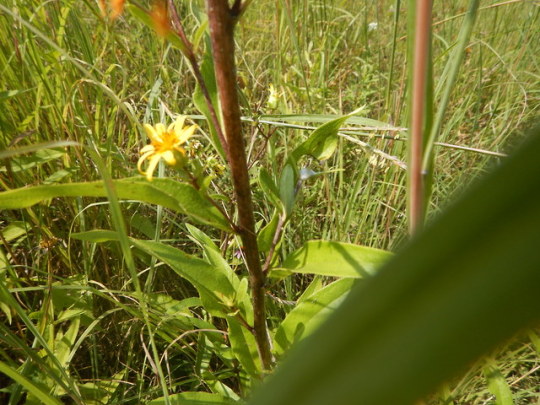
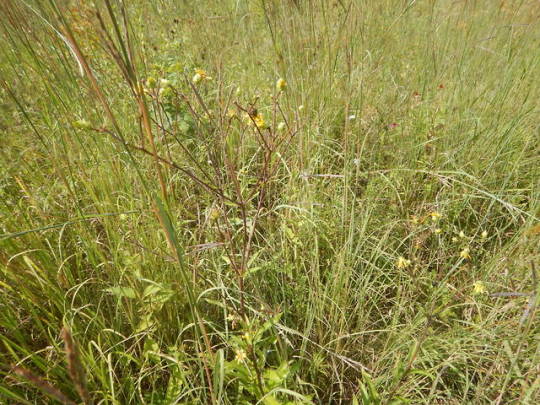

Silphium trifoliatum
is much more common along with its compass plant S. laciniatum and tall rosin weed, S. integrifolium. then the S. asteriscus. Unfortunately for this vestige of a southern prairie pocket in what was otherwise prairie less unglaciated Ohio River Valley, no remnants of the Prairie Dock were located in this area, instead, it was introduced to the rest of Glenwood Gardens in their reconstructions much later. Cincinnati, isn’t exactly known to have any pocket prairies left, or even open woods(very few remnant open woods remain). What was a remnant by connectivity and strange preservation alone, Electric/railway, had been completely destroyed by invasive species in most cases by the early 90′s. With that said, Hamilton co. is the only county in Ohio were you can still find both Trifolium reflexum and Trifolium stolonifera near eachother in open woodland habitat, demonstrated by Daniel Boone aka “Carya Guy”, “Weatherman”, or the “Clover Kid”. If you get a chance go check him out on instagram @polyman58.
16 notes
·
View notes
Text

An ex-CPR branchline runs through Horizon, Saskatchewan, splitting off into a siding that services the hamlet's grain elevators, 08/20/2018. Photo by Johnst3c
CPR abandoned this branchline in 1996. In 1999, it was partially purchased by shortline railway operator Red Coat Road & Rail. The Great Western Railway is currently contracted to operate the line, and the Southern Prairie Railway also uses it for tourist excursions.
#saskatchewan#red coat road & rail#great western railway#southern prairie railway#grain elevator#one of horizon's elevators was built in 1922! a century ago!!
0 notes
Photo

910: The Final Sacrifice
I grew up in Calgary, which means that the riff about Edmonton being kind of like hell but less so is at least six times funnier than it would be otherwise. My sister did her IT degree at the same school (the Southern Alberta Institute of Technology) as the people in this movie were taking their film classes. I’ve probably been to places where they shot scenes and didn’t know it… all of which makes The Final Sacrifice particularly dear to my heart, even by MSTie standards.
Seven years ago, young Troy’s father was chased down and murdered by armed luchadors in the woods somewhere. Now, grown into a man of at least twelve, Troy is determined to find the killers. In an attic he discovers a mysterious map and a bunch of information about the ‘Ziox’, but before he can puzzle it out the luchadors attack! Troy escapes by climbing into a truck driven by Canada’s second-greatest hero (after Wolverine), the one, the only Zap Rowsdower. Together, the two of them set out to conquer Zap Rowsdower’s car trouble and uncover the secret of the Ziox, a lost civilization that once ruled the land of Fish Creek Provincial Park!
First, some Canadiana. The Lemon Mine is a legendary lost gold deposit supposedly found by prospector John Lemon. Also, Maple Syrup Rustling is a thing that goes on in Canada. Over the winter of 2011-2012, nearly three thousand tonnes of it were stolen from the Federation of Quebec Maple Syrup Producers, one barrel at a time. Canadians regard this in the same way as other countries might think of big art or bank heists, with the perpetrators becoming folk-culture heroes. Also also, Brain Guy was wrong. The worst thing ever to come out of Canada is, hands down, our geese, which attack livestock, destroy aircraft, and don’t even taste good. They are the worst of all birds and we apologize.
Second, some racism. According to the movie, the Ziox were a lost civilization who lived in Southern Alberta eleventy thousand years ago, “way before the Indians” and built cities of gold in the middle of the prairie. Since Sartoris and Zap Rowsdower, among others, are descendants of these people it appears they were supposed to be white. Because there’s no way anybody who wasn’t white could have built huge cities full of golden pyramids, right? It’s not like there were entire cultures in the Americas who were known for exactly that!
Those peoples didn’t live in southern Alberta, though, for the excellent reason that there’s nothing here. This area is miles upon miles of rolling grassland, from the foot of the mountains all the way to Manitoba, with not much in it but buffalo and buffalo by-products. There’s some sandstone you can build quaint town halls with, but not pyramids that will last thousands of years. The wildlife aren’t suitable for domestication. There’s no meaningful amount of gold. There weren’t even very many trees until Europeans started planting them as windbreaks. For as long as there’s an archaeological record, the indigenous peoples around here have been nomadic hunters. Permanent settlements couldn’t get started until the railway arrived to bring in supplies.
On to the movie. When you want to tell a big story but have only a little budget, one popular way to do it is by having most of your adventure happen in the middle of nowhere so you can save your money to make a big impression in only a few key scenes. Take, for example, The Princess Bride, which is mostly just a few people in the wilderness but put enough into the palace sequences to make us believe we were in a Renaissance-era world. The Final Sacrifice is a stellar example of a film that’s too damn cheap to even get away with that. They wanted demonic idols and spectacular caverns and an ancient city rising from the earth but all they got is a bunch of toothpick models and papier-mache, almost as pathetic as the dinosaur puppets in Future War.
The nail in the coffin is that The Final Sacrifice can’t even do wilderness very well. The outdoor scenes are in very open scrub, which are rather desolate but don't give the impression of somewhere miles from civilization. It looks, like I already observed, a lot like Fish Creek Park, which is about a twenty-minute walk from where I grew up and sees a steady stream of picnickers and brownie troops all summer. Any given shot in The Final Sacrifice looks like if you moved the camera three inches to one side you’d see a bunch of little kids making s’mores.
I’m pretty sure the writers originally had something much grander in mind, and had to tone it down a lot to get it to the screen with the money they had – because when you think about it, it’s obvious that The Final Sacrifice is a story about the lost continent of Atlantis. You’ve got an ancient advanced civilization that was punished for its hubris and blasphemy by sinking, and which promises untold power and wealth to whoever can find its remains. That’s a tale that ought to span continents, with adventurous archaeologists and deserted isles and plane crashes and such things… but all anybody had was a small town and some back woods a few hours’ drive out of Calgary, so they had to make do. The result feels like a story trying to be bigger than it is, as if the events in the movie only think they ought to have world-shaking implications but actually don’t matter to anyone.
Adding to the impression that there’s something missing from this movie, the story depends an awful lot on some very odd coincidences. I can buy that Troy lives only a couple hours’ drive from the site of the Ziox city – that’s where his father lived and worked, and since Troy’s aunt didn’t know about the cultists there was no reason for her to move. But then the truck he climbs into just happens to belong to a former member of the cult? Zap Rowsdower is supposed to be an alcoholic drifter who just wants to get away and forget, so why the heck is he still in the area? Canada is big. Go to Halifax. Go to Resolute Bay. Hell, leave the country. Why stick around within a few miles of the evil cult that threw you out?
Then there’s Pipper. He’s been hiding from the cult for years, he says, but he’s doing it in a cabin about ten meters (that's thirty-five feet for the Americans in the audience) from the site of the idol! That might make sense if he were guarding it, but he doesn’t know it’s nearby and professes to believe it’s just a legend. So what is he doing there? Movie audiences can handle magic and aliens and all kinds of other ridiculous things, but too many coincidences will kill suspension of disbelief in a way the overtly fantastical never can.
When you want to tell a big story in your movie, it’s also helpful if the audience knows what the characters want and what will happen if they fail. On the first count, I guess The Final Sacrifice does okay. We do know that Troy wants to find out why his father died and what’s up with all this stuff he left behind, and Zap Rowsdower just wants to get away from this distasteful part of his past but is sucked back into it by Troy whether he likes it or not. On what will happen if they fail, however, the film is much less clear. Sartoris talks about raising an army of invincible warriors and conquering the world, but it’s not clear how making a sacrifice to the idol in the woods will bring that about. Does Sartoris believe the city will arise full of undead soldiers or something? The only version of the associated legends we get comes from Pipper, who says nothing about any such thing. We’re obviously meant to believe that at least some of the population escaped the sinking, since they had to go give rise to descendants like Zap Rowsdower and the luchadors.
The ending is clearly supposed to be ironic, as it is Sartoris’ death that satisfies the idol and raises the city from the ground. This would have been more effective if Sartoris himself had lived long enough to appreciate the irony, but that much works well enough. The rest of the events at the end of the film just leave way too many questions. What happened to all the luchadors? They pull off their masks and walk into the light and out of the movie. Why did Zap Rowsdower’s tattoo disappear? Does Sartoris actually have some kind of magical powers, since he seems able to telepathically contact Zap Roswdower in his sleep? Did the city actually blast off into space, possibly taking the luchadors with it? Because there are definitely shots that make it look like that’s happening. What’s going on there?

Honestly, that’s not a bad explanation. Throwing some Erich Von Daniken, Pumaman or Hangar 18 bullshit into this would actually have made way more sense. Wow, is that ever sad.
It’s easy to be really hard on The Final Sacrifice because it is so very cheap, but on the other hand it was literally made by first-year students at a polytechnic not known for producing filmmakers. When you think of it that way, it actually looks surprisingly like a real movie… but still not enough that it should ever have been released into the wild. The fact that Tjardus Greidanus’ imagination was so much bigger than his budget makes it seem like he had some honest potential. He’s still making both narrative and documentary films, and I’m kind of interested to see some of them.
61 notes
·
View notes
Text
Jules Verne talks about American trains and talks of Mormons and "indians" on the same sentence.
“From ocean to ocean”—so say the Americans; and these four words compose the general designation of the “great trunk line” which crosses the entire width of the United States. The Pacific Railroad is, however, really divided into two distinct lines: the Central Pacific, between San Francisco and Ogden, and the Union Pacific, between Ogden and Omaha. Five main lines connect Omaha with New York.
New York and San Francisco are thus united by an uninterrupted metal ribbon, which measures no less than three thousand seven hundred and eighty-six miles. Between Omaha and the Pacific the railway crosses a territory which is still infested by Indians and wild beasts, and a large tract which the Mormons, after they were driven from Illinois in 1845, began to colonise.
The journey from New York to San Francisco consumed, formerly, under the most favourable conditions, at least six months. It is now accomplished in seven days.
It was in 1862 that, in spite of the Southern Members of Congress, who wished a more southerly route, it was decided to lay the road between the forty-first and forty-second parallels. President Lincoln himself fixed the end of the line at Omaha, in Nebraska. The work was at once commenced, and pursued with true American energy; nor did the rapidity with which it went on injuriously affect its good execution. The road grew, on the prairies, a mile and a half a day. A locomotive, running on the rails laid down the evening before, brought the rails to be laid on the morrow, and advanced upon them as fast as they were put in position.
The Pacific Railroad is joined by several branches in Iowa, Kansas, Colorado, and Oregon. On leaving Omaha, it passes along the left bank of the Platte River as far as the junction of its northern branch, follows its southern branch, crosses the Laramie territory and the Wahsatch Mountains, turns the Great Salt Lake, and reaches Salt Lake City, the Mormon capital, plunges into the Tuilla Valley, across the American Desert, Cedar and Humboldt Mountains, the Sierra Nevada, and descends, viâ Sacramento, to the Pacific—its grade, even on the Rocky Mountains, never exceeding one hundred and twelve feet to the mile.
Such was the road to be traversed in seven days, which would enable Phileas Fogg—at least, so he hoped—to take the Atlantic steamer at New York on the 11th for Liverpool.
The car which he occupied was a sort of long omnibus on eight wheels, and with no compartments in the interior. It was supplied with two rows of seats, perpendicular to the direction of the train on either side of an aisle which conducted to the front and rear platforms. These platforms were found throughout the train, and the passengers were able to pass from one end of the train to the other. It was supplied with saloon cars, balcony cars, restaurants, and smoking-cars; theatre cars alone were wanting, and they will have these some day.
Book and news dealers, sellers of edibles, drinkables, and cigars, who seemed to have plenty of customers, were continually circulating in the aisles.
15 notes
·
View notes
Text
What is the future of rural spaces?
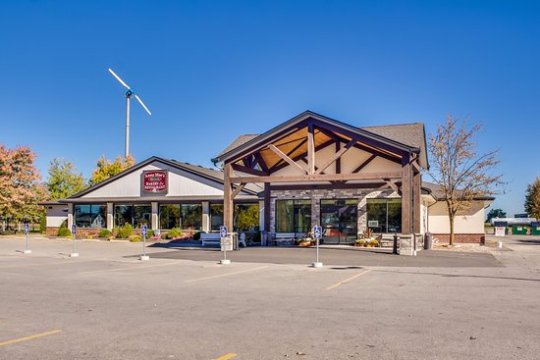
Anna Mae’s Bakery & Restaurant in Millbank, Ontario.
At the beginning of this course I had a pretty vague understanding as to what rurality was. As most naive young folks believe, I had this impression of rural spaces that was very much agricultural-based, leaving little wiggle room for other ideas and different perceptions of the countryside to exist, those of which were very much inspired from nature and the outdoors. I am now entirely a believer in the diversity of rural spaces in Canada, those of which range from small, quaint little towns such as Millbank, Ontario to what one could call the vast wilderness in both Banff and Jasper National Parks.
With all of these landscapes, rural by nature of course, one must beg the question - what is their future? In the next 50 years what will become of these places, the vast diversity of rural spaces that we have all come to know and love?
I found this question a little disheartening, to be truly honest. Not the question itself, but the direction my answer was going. Based on what I’ve learned throughout this class, rural spaces are far from appreciated within society. Not only is the rate of urban expansion and sprawl growing, but there are no measures to prevent this from occurring. Land preservation initiatives are overall very ineffective in Ontario and other areas in Canada. In addition, with an increased number of people moving into cities, urban areas are pressured to expand despite perceived barriers such as green space.
For the purposes of the blog prompt this week, I will discuss each of these issues in detail.

Urban Expansion, Sprawl, & Population Growth:
As I’ve illustrated in other blog posts previous to this, urban expansion is a serious issue in Ontario. In a report released by the University of Guelph titled “Protecting Southern Ontario’s Farmland” (I’ve definitely referenced this before), a significant amount of land, more particularly the agricultural landscape, is continually threatened due to urban development and sprawl.
Between 1981 and 1986 prime agricultural land represented 59% of all land in Canada that has been converted to urban uses. In 1996 19% of all Class 1 agricultural land in Canada was occupied by urban development - this percentage increases each year. In fact, urban centres consume land equal to the size of Hamilton, Ontario every year.
At the current rate an additional 260,000 acres (1,070 square kilometres) will be urbanized by 2021 in areas north of Toronto, a space almost double the size of Toronto currently.
How do we combat this? How do we inspire change to protect our farmland and precious green spaces?
I don’t know if there is an adequate solution to this problem. In Toronto for instance, census data from 2016 indicates that this city grows at a rate exceeds the national average. Since the last census in 2016 the population of Toronto increased by 6.2 percent, representing nearly 2 million people. City planners are encouraged by legislation and the creation of the Green Belt to build upwards rather than outwards, but at some point these restrictions will not be enough. This is especially the case with a growing immigrant population.
Nearly half of Toronto’s population is represented by new Canadians, those of which move to the city for the resources, jobs, and the pockets of familiar communities this urban centre provides. Homes need to be built, apartments need to be raised - the need for housing will not vanish any time soon, not in Canada’s largest city and most substantial immigrant ‘magnet’ so to speak. Toronto remains as Canada’s top destination for migrant populations, despite a growing interest in the prairies.
Lack of Land Preservation:
Some people believe that a growing movement to protect and preserve rural landscapes will help to prevent urban expansion and sprawl. The Greenbelt for instance, is considered as a great success in southern Ontario. With over two million hectares of valuable farmland, forests, wetlands, and watersheds protected in the Greater Golden Horseshoe region, development initiatives are virtually non-existent. The Places to Grow Act, developed alongside the Green Belt, legally reinforces and encourages the growth of major cities where it is needed most - downtown cores.

The Green Belt.
Or so people think.
Yes, both the Green Belt and Places to Grow act are successful, but what about those spaces beyond the Green Belt? Areas like Shelburne, Guelph, and Barrie?
Leap-Frog Effect:
This legislation has unknowingly curtailed the development of new subdivisions and housing complexes to the edges of the Greater Golden Horseshoe (GGH) - to those communities and municipalities that have access to major highways such as 400 and 401, but are not necessarily prepared for a new commuter population. This anomaly is recognized as the leap-frog effect.

Changing Land-use in Southern Ontario. The large red area in the centre of the map is the Simcoe County area.
The above map is from a research project conducted by Jonathan Scida using GIS technology. According to this figure, many municipalities within the southern half of Simcoe County, just outside the reach of the Green Belt, have experienced increased levels of urban sprawl and development. This is a result of close access to major highways and arterial roads, those of which are viable transportation options to access Toronto for employment purposes.
Developers are drawn to this land because it’s largely unprotected, land is cheap, and people will flock to these areas for a chance to live in homes that are within reach of the city. As a result of this, those communities outside of the Green Belt are largely ignored and are forced to face continued development and loss of agricultural land. This is a problem as 70% of Ontario’s prime agricultural land lies outside of the Green Belt boundary.
No Legislation to Protect Agriculture:
What about legislation?
As I’ve mentioned before in previous blogs, this is largely ineffective as well. Currently the protection of agricultural land isn’t legislated in Ontario - in Canada. The Green Belt may exist, but it does very little to change how agricultural land is treated in regards to its land use. Yes, this land may be used to produce food, but on a legal-level it is considered the same as land that is used for purely commercial or residential purposes, all the result of the Planning Act, 1990.
As illustrated within a report released by the Ontario Federation of Agriculture, “Ontario’s current land-use planning system is geared towards the accommodation of urban (residential) development and other urban-related land uses within the framework of “good planning principles”. Within this framework, farmland is typically viewed as a background landscape upon which development is to be painted, or in other words, as tarmac in-waiting”.

As this continues to occur other policy tools such as land easements, stewardship programs, and land trusts prove to be inadequate. These tools are largely undeveloped and depend on volunteers for their successful functioning.
In addition, decisions are routinely made that negatively impact agricultural interests and often act to ignore the needs, wants, and demands of farmers. Plans are often put forward that undermine agricultural interests and there is very little pressure and motivation for planners and developers to evaluate the true impacts of their activities on the ability farmers have to preserve and act as stewards of their lands. Parcels of land are often divided as a result of construction and serve as barriers between farmed lands.
Despite the fact that agriculture is integral to Canada and Ontario’s economy, policy and decision-makers are deaf to the needs of farmers. Farmers have no voice, and this is only going to increase in the near future if legislation and planning does not change.
Tourism & Creative Destruction:
Finally, in the future rural tourism is likely to increase across Canada and within the province of Ontario. Rural areas offer tourists an assortment of unique experiences that are not easily replicated elsewhere in the world. Not only does the countryside offer people the ability to relax, experience nature, and the great outdoors, but allows people to develop an appreciation for a culture, history, and heritage that is unlike their own.
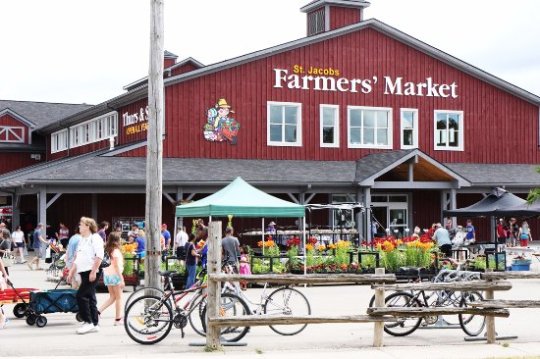
St. Jacobs Market.
St. Jacobs for instance, a community 20-30 minutes north of Waterloo in Ontario, offers tourists the chance to experience the local Mennonite culture and purchase local foods, goods, and produce from an internationally recognized farmer’s market, one that is home to over 300 vendors offering a good deal. If people have the desire to do so, they may partake in a horse and buggy ride, walk on some of the local trails alongside the Conestoga River, or check out the model railway downtown.
Although these experiences are largely successful in bringing tourists into the area, generating jobs for the local population, and a surge of wealth that acts to help renew the community, it must be mentioned that many rural towns and villages that become tourist hubs often succumb to what is known as the “tourist gaze” or “creative destruction”.
What do these terms mean?
Rural spaces such as St. Jacobs are heavily transformed and commodified to meet the needs of tourists, largely urbanites. Heritage is over-exaggerated and buildings and destinations are designed to appear as though they originate right from a time in the distant past. A perfect example of this is the Tim Hortons in St. Jacobs. This building, as seen below, is purposefully designed to look very similar to a ranch.
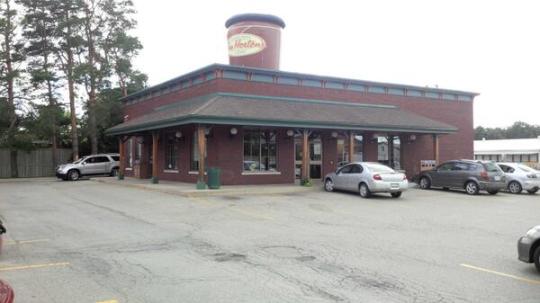
St. Jacobs Tim Hortons
Yes, this may act to preserve rural areas and St. Jacobs in a sense, but it must be argued that the authentic aspect of rural communities is lost as a result of this. The opinions, stories, and views of local populations are lost as a result of continued changes that reflect the urban view of what constitutes as rural (rural idyll).
Will this be the case for all rural towns and villages in the future? I really hope not, but I have my doubts.
As I mentioned a bit earlier, I’m more than a bit disheartened. The future of rural communities and landscapes is looking pretty bleak, especially based on all the research we’ve had the opportunity to conduct in class. Fortunately, I haven’t lost all hope.
I think that it’s our responsibility as educated citizens and students to play a role in advocating for rural spaces. We need to fight for the voices of farmers and open up the metaphorical political, social, and economic doors that act as barriers to their speech and allow them to be heard within society. We need to fight for better land-use laws and legislation to protect farmland and green spaces. We need to fight for the better management of tourism - authentic tourism if that’s even possible. We need to be spokespeople for our home and native land (insert Canadian national anthem here).
I know that I’m hardly inspiring, but I think that my point has been made. We need to do better and make better decisions if we plan on improving the future of rural spaces in Canada. We can’t expect positive change to happen - we need to be advocates and make positive change happen!
- Vanessa
2 notes
·
View notes
Note
I am in a glorious, Shamy filled fluff bubble right now after watching the wedding and I all want to do is spend the entire hiatus reading Shamy honeymoon fics, haha. As my favourite Shamy writer, I would absolutely love to read your take on their honeymoon!! Thanks so much.
Thank you so much, Anon! I’m still not over the wedding either. I always pictured them taking a train, so I wrote about a railway excursion, romance and Sheldon’s favorite mode of transportation rolled into one. This is part 1 of 2. I plan to post part 2 early next week. I hope you enjoy!
As Sheldon held his wife’s hand in the train station, memories of Valentine’s Day 2014 came flooding back to him. It was fitting that they would be traveling by train for their honeymoon, as the first time they had used that mode of transportation together was when he had finally admitted to himself that he had romantic feelings for her. Had it really been four years since he initiated that kiss? If he concentrated hard enough, he could almost taste the brownies on her lips.
This trip had been a joint decision. After Amy vetoed his request to spend their honeymoon in Switzerland to see the CERN supercollider and he vetoed hers for a Little House on the Prairie excursion, she suggested something they both could enjoy - something romantic to satisfy her needs as well as something that fit his interests. A lightbulb went off as he recalled how they combined the two elements on that fateful trip, and he proposed re-creating the best moments.
Doing the exact same route crossed their minds, but as they looked at itineraries, they found one that included an overnight stay on the train itself. And instead of stopping in wine country, this one would take them to Seattle. Neither had ever been, so Sheldon reasoned going to a new place together to start their married life was perfect. Amy had been thrilled with the idea, so it was settled.
He caught her staring at him out of the corner of his eye. He smiled at her lovingly and squeezed her hand, the hand with the ring he had placed on her finger two days earlier. Subconsciously he stroked his own ring with his thumb. The cool metal band on his finger felt foreign to him, but in a good way. It reminded him of the commitment they made to each other, of the bond they shared that strengthened every day.
An overhead announcement interrupted his thoughts. “We will now begin the boarding process for the Coast Starlight with service to Seattle…”
Amy adjusted her purse strap, her eyes shining. “That’s us.”
They followed their fellow passengers to the platform. Much to Sheldon’s relief, there was no pushing or shoving to enter the train. When it was their turn, he held out his phone to the conductor to scan their e-tickets, and within minutes they were on the observation level admiring the panoramic views of downtown Los Angeles through the floor-to-ceiling windows.
“Wow!” Amy exclaimed. “With all these windows, we won’t miss a thing.”
“And because I reserved us seats on the left side, we’ll have spectacular views of the ocean as we head north.”
“Oh, Sheldon!” Amy reached up and kissed him firmly on the lips.
“Amy!” He looked around wildly at their fellow passengers, but no one appeared to be paying attention. “Let’s wait until we do our re-creation,” he murmured.
“I’ll try to be patient. Shall we take our luggage to the room?”
“I’ve got it. Make yourself comfortable by the windows.”
Sheldon dodged the passengers coming in as he carried their suitcase downstairs to their sleeping quarters. After squeezing it into a corner, he took a few moments to assess the space but didn’t dwell on the cramped quarters. They wouldn’t be spending much time there anyway, at least not during the day. When he rejoined his wife a few minutes later, she had taken a seat and draped her sweater over the adjacent one. He pecked her cheek when he lowered himself into the saved seat and took her hand in his.
As the train pulled away from the station, they watched the sights of LA fade away into the scenic coast of southern california. An hour into the ride, Sheldon apprised her of the amenities the train possessed, but Amy was happy just to enjoy the view. He had to practically tear her away from her seat to the dining car when the dinner announcement sounded overhead.
“Good evening,” their waiter greeted them. “Our specials tonight are the filet mignon, the grilled seared Norwegian salmon, and the butternut squash risotto. I can offer you wine recommendations for each…”
“I’m sorry,” Sheldon interrupted. “I heard you serve a seafood risotto, but I don’t see it listed on the menu.”
“My apologies, Sir. We have a rotating menu, and unfortunately it is not one of the choices tonight. It’s one of our Wednesday options.”
“That won’t work. My wife and I are trying to re-create our Valentines dinner from four years ago. We had the seafood risotto. I suppose you don’t have brownies either.”
“Perhaps the southern pecan tart will be to your liking.”
“It will not.”
Amy glared at him. “Sheldon! We’ll need a few minutes to decide,” she informed the waiter.
When he was out of earshot, Amy reached across the table, resting her hand on her husband’s. “Sheldon, it’s okay. It’s not like we’re doing an exact re-creation. If we were, we’d be on a train to Napa Valley with Howard and Bernadette.”
He sighed. “I know. I was just hoping we could re-create the magic of that kiss. I’m most disappointed they don’t have brownies.”
“We don’t need brownies to share a magical kiss. Every kiss still leaves me weak in the knees.”
He looked at her uncertainly. “The pecan tart does sound good.”
“It does. Maybe I’ll leave a little extra on my lips for you to lick off.”
“Vixen,” he muttered.
The waiter eyed them apprehensively when he made his rounds back to their table. “Are you ready to order?”
“We’ll have the butternut squash risotto and the pecan tart,” Sheldon informed him.
“Very good. Would you care for some wine?”
Amy edged her glass closer to him. “Yes, please.” She looked at Sheldon who shook his head politely. “Just one glass of whatever goes well with the risotto.”
They were both pleased with their entrée choice, with Amy raving that it was even better than the seafood variety on the wine train. She lifted her glass to his milk glass, and they toasted to their new chapter of life.
“And to many more railway journeys together,” Sheldon added.
When the dinner plates were cleared, he reached across table and stroked her left hand, paying extra attention to the antique ring, as they gazed into each other’ eyes. He’d been a fool to think it was a silly tradition. He loved the way her brilliant green eyes sparkled when she excitedly dicussed the activities they had planned for Seattle. He studied every fleck, committing them to memory. Though they’d been together eight years, their relationship felt as new and exciting as if they were just beginning. In a way they were with their new marital status.
They lingered over dessert and herbal tea, just enjoying each other’s company. When there were only two other couples remaining, Sheldon stood, and Amy followed suit. He held up her wine glass, noting she had left a sip for him.
“I’m sorry this isn’t the re-creation we had planned. Dinner and dessert were different, and we’ve already gazed into each other’s eyes, so we’re doing this out of order,” he apologized.
“Honestly, a re-creation seemed like a brilliant plan in theory, and while I will always cherish that moment we shared four years ago, we’ll never be able to replicate it. Even if we come close, it won’t be the same. It was the spontenaiety that made it so special the last time.”
“Perhaps I shouldn’t kiss you here then. I’ll surprise you when you least expect it.”
“I didn’t say that, though I do like the idea of a surprise. Why can’t we do both?”
“Alright.” He licked his lips and took a swallow of the fermented liquid. “Oh, dear Lord! That really does burn! I mean mmm… wine, grape juice that burns.”
She chuckled, and he joined in at the absurdity of it. This was not going exactly to plan, but the mood was a lot lighter than the last time. He hoped that would only make their pending liplock even better, though it would be hard to beat.
He ran his tongue along the inside of his mouth and swallowed the bitter remnants left behind. Then just like on that fateful night, he leaned in, his lips connecting with hers, as he slowly stood upright with his hands on her hips. She pressed herself closer. Her hands, instead of hanging limply at her sides as they had the last time, kneaded his shoulders. Her fingers quickened the pace and the pressure increased when he prodded her lips with his tongue. He needed to taste every bit of her.
“Wow!” She exclaimed when they came up for air. “That was nice… better than nice… much, much better.”
“Good.”
The couple seated across from their table gaped at them, but Amy didn’t care.
Sheldon tugged on his collar. “Perhaps we should call it a night,” he murmured in her ear. He entwined his fingers with hers and tugged her hand.
“Where are we going?”
“I was going to our room. Do you want to come with me?” He wiggled his eyebrows suggestively.
“I do.”
34 notes
·
View notes